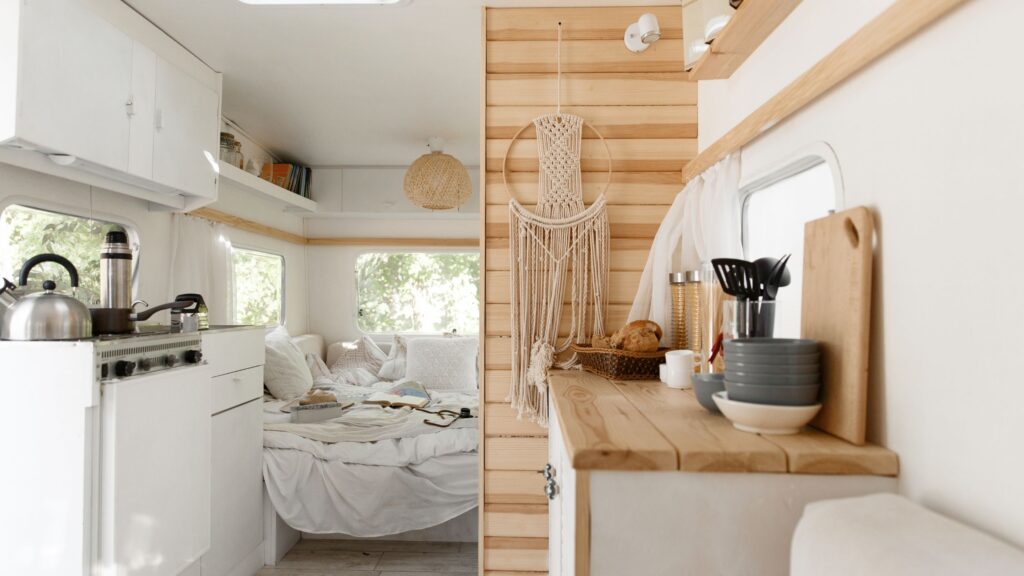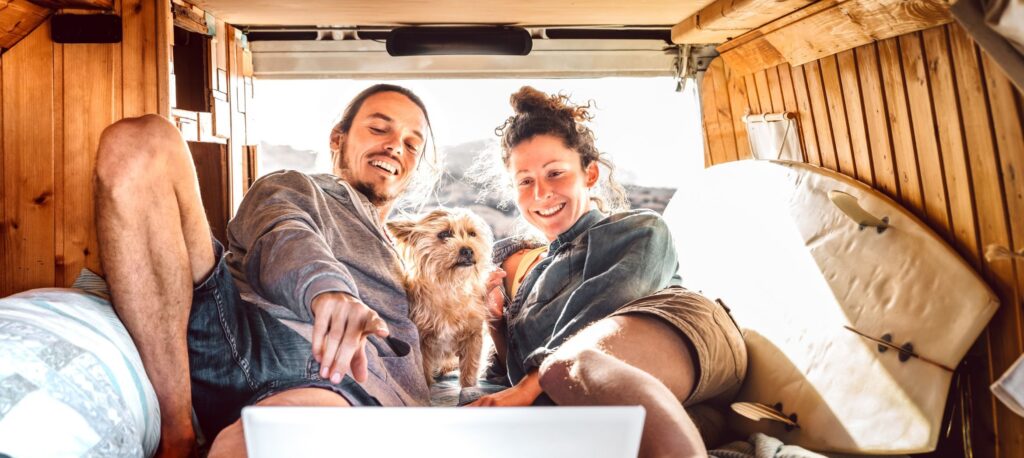If you’re considering building, purchasing, or renting a campervan (also called a class B van conversion), you have probably come across campervans that have been manufactured by large companies, as well as smaller, professional van conversions.
If you’ve ever wondered what differences there are between a manufactured campervan and a professionally converted campervan, we’ve got all the details for you! Our very own David Lewis spent some time traveling and decided to rent three different types of campervans so he could see the difference himself.
In this article, we will define a Class B RV and delve into the differences between those built by major manufacturers and those created by campervan conversion companies based on David’s first-hand experience.
Table of Contents
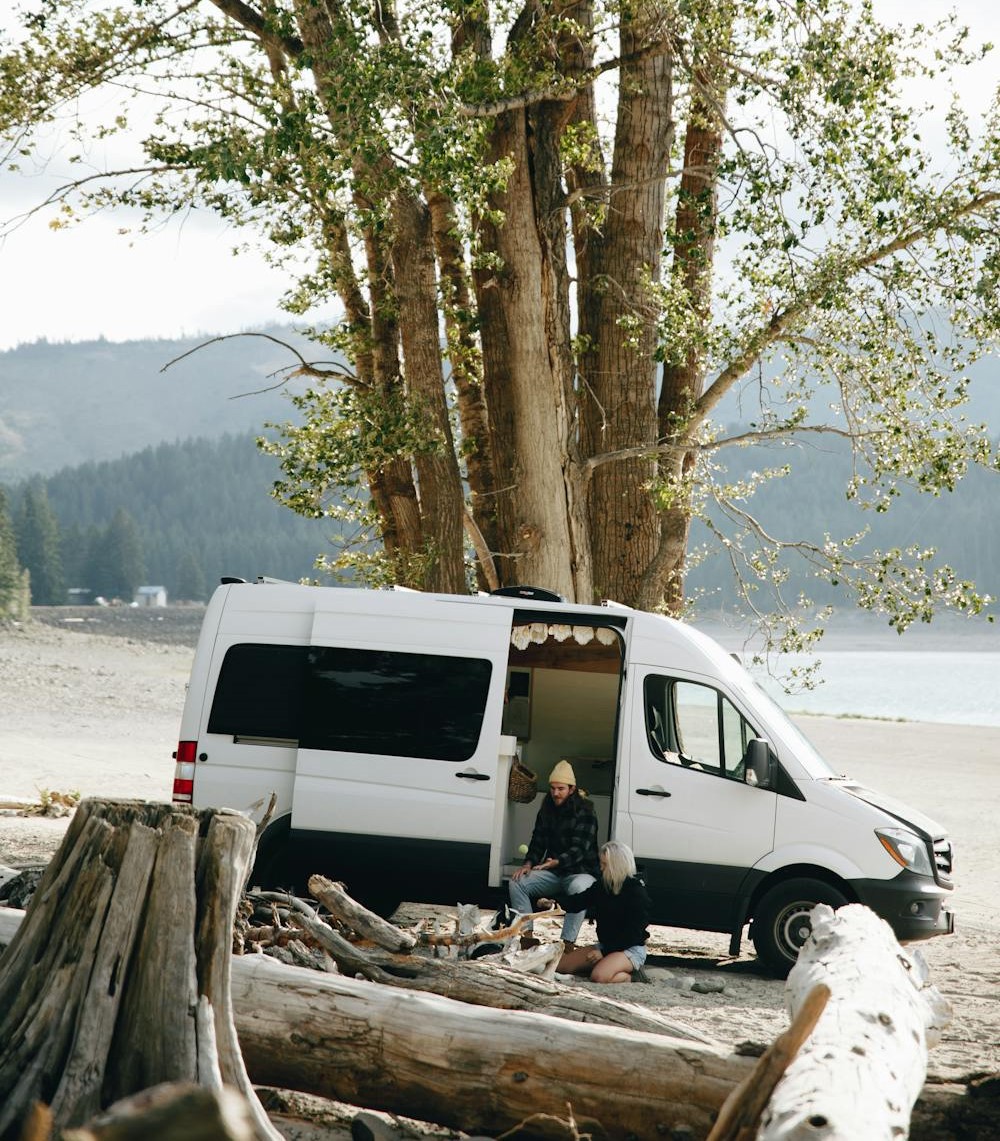
What is a Class B RV?
Class B RVs, also commonly referred to as campervans, are motorhome types that provide a convenient and versatile way to travel. Smaller than Class A and Class C RVs, Class B camper vans are usually between 16 and 21 feet in length, making them more maneuverable, fuel-efficient, and easier to park.
The defining characteristic of most Class B RVs is that they are typically built on a van chassis, which allows for greater mobility and better handling on the road.
Key Features of Class B RVs:
- Compact Size: Class B campervans are smaller, resembling large vans. This suits those who prefer a more nimble and less imposing camper van that is easy to drive and gets better gas mileage.
- Versatility: They are designed to serve multiple purposes, offering both living and driving capabilities. This means you can use them for daily transportation and extended travel.
- Amenities: Despite their compact size, Class B RVs have various amenities, often including a kitchen, bathroom, sleeping area, and a small dining space.
- Mobility: Their van chassis provides excellent maneuverability, allowing you to navigate through urban areas and park in regular-sized parking spaces.
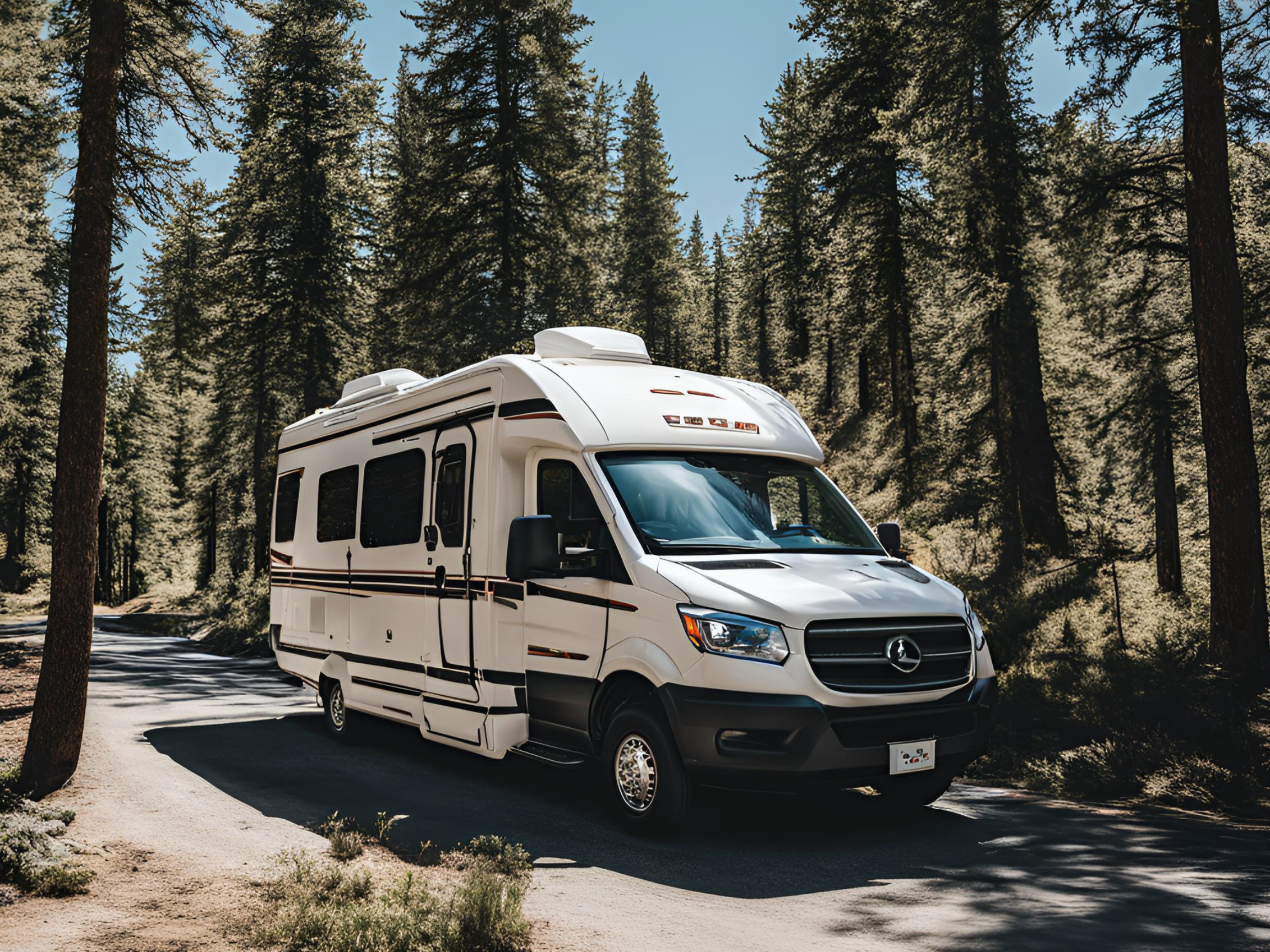
Major Manufacturer vs. Campervan Conversion Company
When considering class B van conversions, one of the primary decisions you will need to make is whether to purchase one built by a major manufacturer or one that a campervan conversion company has converted. Both options have their own set of advantages and disadvantages:
Major Manufacturer Class B RVs:
Major RV manufacturers, such as Winnebago, Airstream, and Roadtrek, produce Class B RVs from the ground up. These are purpose-built, fully integrated recreational vehicles, that are designed to be an RV from the very beginning.
Advantages:
- Quality and Reliability: Major manufacturers are renowned for their commitment to quality and safety standards. Their Class B RVs are constructed to meet strict industry regulations.
- Warranty: These vehicles typically come with manufacturer warranties, which can offer peace of mind to buyers.
- Resale Value: Major manufacturer RVs often retain better resale value due to their established brand reputation.
- Amenity Options: You can choose from a range of floorplans and amenities, often customizing the RV to your liking.
Disadvantages:
- Higher Cost: Major manufacturer Class B RVs tend to be more expensive due to the quality and amenities they offer.
- Limited Customization: While you can choose from different options, major manufacturer RVs may have limitations in terms of customizing the vehicle to your exact specifications.
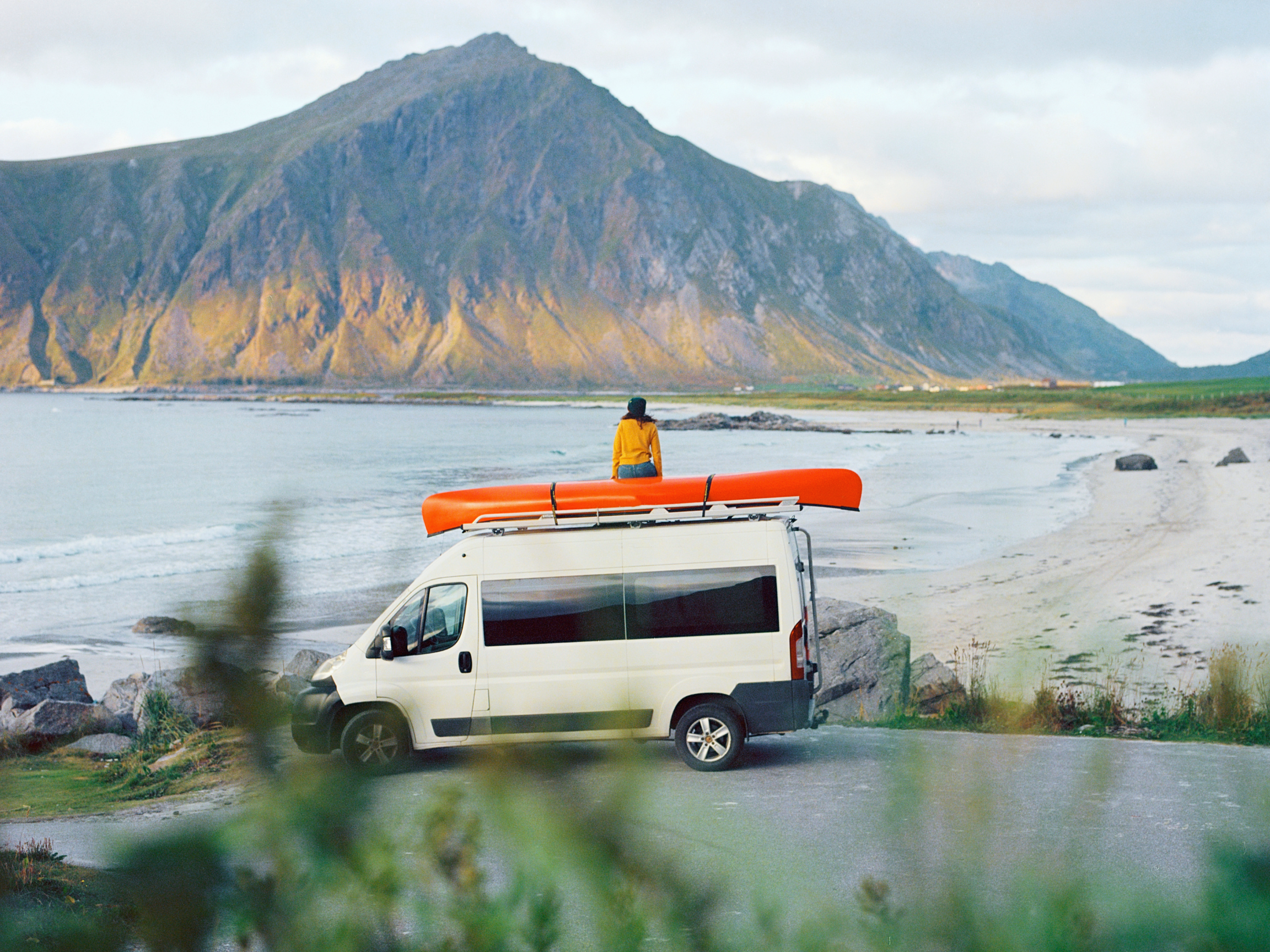
Campervan Conversion Company Class B RVs:
Campervan conversion companies take existing cargo vans, often from popular manufacturers like Mercedes-Benz, Ford Transit, or Dodge Ram, and transform them into fully functional Class B motorhomes. These conversions can vary greatly in terms of quality and customization options.
Advantages:
- Affordability: Depending on the amenities included, campervan conversions are typically more budget-friendly than their major manufacturer counterparts, making them accessible to a broader range of travelers.
- Customization: Conversion companies often offer a high level of customization, allowing you to tailor the Class B campervan to your specific needs and preferences.
Disadvantages:
- Quality Variability: The quality of campervan conversions can vary widely, depending on the company and the materials used. Research and reviews are crucial to ensure you get a well-constructed conversion.
- Warranty: Conversions may not come with the same level of warranty coverage as major manufacturer RVs, leaving you responsible for repairs and maintenance.
- Resale Value: Conversions tend to have lower resale value than major manufacturer RVs due to the lack of brand recognition and standardization.

First-Hand Experience: Living in Both a Manufactured and Professionally Converted Campervan
As the founder of Explore VanX, David Lewis is no stranger to van life. He’s lived full-time in a DIY camper van conversion van and rented various professionally converted Class B camper vans for weeks-long trips over the years.
Since his experiences to date were with professionally converted or DIY campervans, he decided to rent a manufactured class B RV back-to-back with a professionally converted class B van conversion. A Dodge Ram Promaster 2500 Winnebago Travato, THOR Motorcoach Scope 18, and a Mercedes Sprinter 170 converted campervan from Live More Outdoors.
Here are his takeaways from the experience and what he would suggest others consider before trying either type of class B van conversions.
Campervan pickup experience
When renting a campervan for any length of trip, the pickup experience can make a huge difference between a successful or a frustrating adventure.
David quickly learned that when you’re picking up a Class B RV from a large manufacturer, it’s more of a business transaction than a shared experience. He was handed the keys, and that was about it. Not a poor experience, but not very personable.
However, when he picked up the professionally built campervan from Live More Outdoors, the experience was much more personable and pleasurable. The owners were previous van lifers and knew all the things to point out and show David before his big trip. It was almost like talking to an old friend!

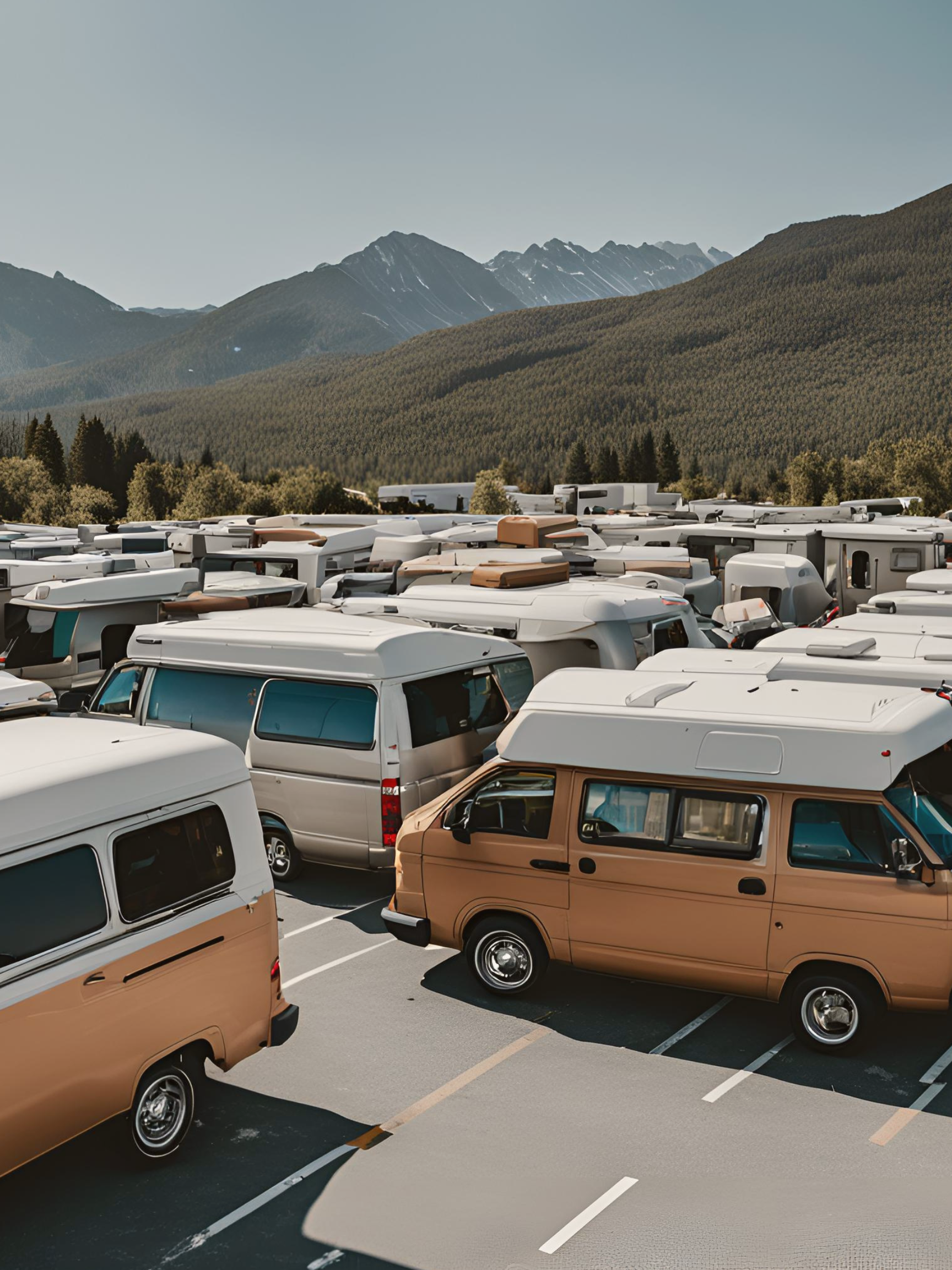
Driving comfort
When logging hundreds of miles in a camper van to explore the countryside, driving comfort is important to ensure you stay alert and aren’t so worn out from the drive not to enjoy the destination.
David felt all three camper vans were comfortable and easy to drive long distances. The Winnebago Travato and the THOR Motorcoach Scope 18 drove more like a big car, and the converted Mercedes Sprinter felt more like a truck but still comfortable to handle.
One thing that took some getting used to was the wind assist in the Mercedes Sprinter. If a big gust of wind came up or he went over 70MPH, the wind assist would kick in, and if you weren’t prepared, it was a big surprise. One might think something was wrong with the vehicle if you’ve never experienced the feature before.
Amenities for the Winnebago Travato vs. a THOR Motorcoach Scope 18m vs. a Professionally Converted Camper Van
When you’re taking a long trip in a camper van, it’s essential to have the right amenities for whatever your plans are. Typically, this includes time off-grid, spending time in the outdoors, and cooking your own meals.
On this trip, David was traveling with his toddler, Summit, so he had additional needs for space and safety. Here’s how things stacked up between the three class B camper vans:
Manufactured Winnebago
Overall, the Winnebago Travato was fine for an occasional trip and was equipped well enough to sustain someone for quite some time off-grid or at a campground.
- The bed setup was Murphy-bed style and extremely easy to set up and put away. You simply put your pillows away in a cabinet, and the rest of the bedding stays on the bed. There were straps to hold the bed up during the day, which gave you much more living space inside the camper van and allowed you to walk through the entire van, front to rear.
- Full wet bath with a shower, hot water, and a toilet with a blackwater tank. The dumping and refill process was simple and convenient.
- The Winnebago had shore power (the ability to plug into an RV electrical hookup) and a generator. Unfortunately, David was never able to get the generator to work, so he had to stay plugged in at a campground on hot days to be able to run the air conditioning.
- There was very limited storage space except under the bed when it was down.
- The living space felt cramped and not homey when the Murphy bed was down.
- A push-button awning was appreciated and quite sturdy, though it probably shouldn’t be left up in a high-wind situation.
Manufactured THOR Motorcoach Scope 18m
One of the first things David noticed was that since the THOR was newer, being a 2022 model, they seemed to have gotten more things “right” than the older Winnebago. Everything was updated, from having plenty of USB ports throughout the van to having a great layout to accommodate van living.
In fact, this model was the exact layout of David’s first van, so it felt very nostalgic, and it was fun to see a “modern-day” version of his old van. This in itself made the THOR campervan his favorite of the three. You get your bang for your buck with this lower-cost pre-built camper, making it a perfect weekend getaway vessel for two or a full-time home for one.
Some of the other features that made this an exceptional rig for vanlife:
- The overall layout of the camper van was simple and clean, making it very comfortable to move about in and felt intuitive.
- USB plug-ins were set up well and easy to use.
- The refrigerator was in a great location and easy to access.
- It has a generator, so you can be off-grid for extended periods of time, even if it’s cloudy out.
- With the lighter chassis, the gas mileage was great compared to other more robust class B RVs.
- The bed system was simple and easy to pull out. This provided more living space during the day since the bed wasn’t “fixed” in place.
- The gray water tank is removable, making it super easy to dump as needed.
- It has a power awning, which is great on hot, sunny days. It felt like the living space was almost doubled!
- There was a bike rack included so you can bring along your favorite hobby!
Mercedes Sprinter Professionally Converted Camper Van
Where the Winnebago was lacking in livable interior space, a homey feel, and functional amenities to sustain you completely off-grid for weeks on end, the Sprinter shone. This is probably due to the fact that the professional van conversion was built by someone who had actually lived in a camper van full-time and understood the nuances of van life.
Here are some of the things that stood out most to David:
- The overall layout of the camper van was great; there was a center area for living with a Lagun table and a TV, which was great for kids!
- With both front seats on swivels, this added much more living space and made the van feel bigger inside.
- There were two separate beds, which was also great for traveling with kids. David used the fixed Queen bed, and Summit had his own bed in the dinette area that was converted into a second bed.
- Although there was not a full wet bath, there was a hidden shower space in a bench seat where a portable composting toilet could be stowed.
- The grey water tank was under the sink and easy to remove and empty.
- With 400W of solar on the roof and 400AH of lithium batteries on board, there was plenty of power to sustain them off-grid without the need for shore power or a generator.
- With the Queen bed in a fixed position, you didn’t have to “set up” and take down the bed every day. You did, however, have to take down the Lagun table to convert the dinette into the second bed if you needed it, which was a little difficult the first few times you went through the process.
- There was tons of storage under the queen bed and throughout the camper van in general.
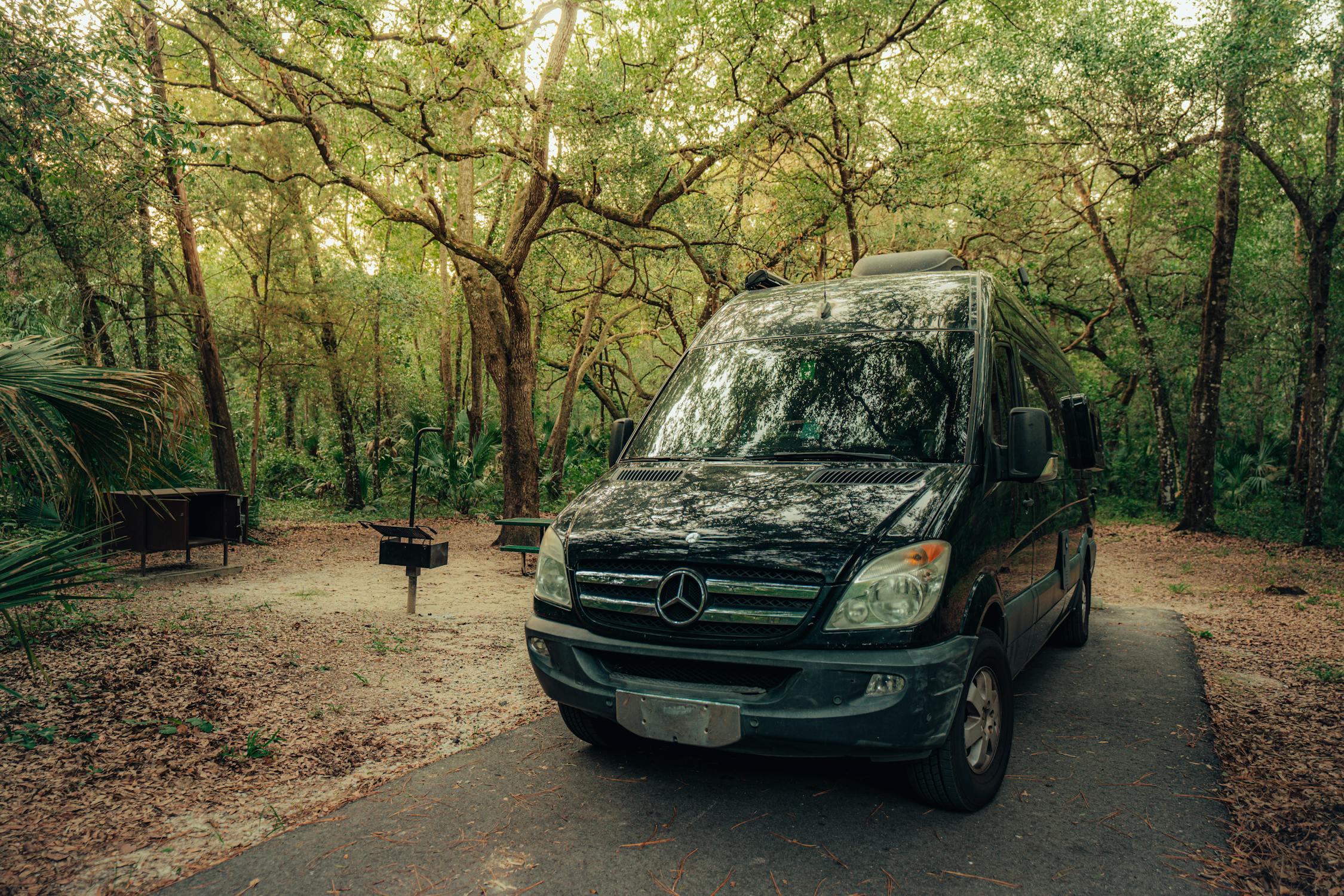
Intuitive functionality of storage, seating, and other accessories
The average person might not realize how important it is to have intuitive functionality in such a small space as a class B camper van. But when you’ve lived in one full-time, you quickly learn what works well for your needs and what doesn’t.
Power plugs and ports for charging electronics
- The professionally converted Sprinter had more than enough USB ports and 110 outlets. They were strategically placed for easy access throughout the living space and worked flawlessly.
- The Winnebago, however, did not have enough ports, and for any of them to work, the campervan had to be hooked up to shore power, or the generator had to be turned on. Since David wasn’t able to figure out how the generator worked, this was very limiting unless he was parked at the campground and plugged into shore power.
- The THOR class B RV had many USBs throughout the camper, and it even offered a lightning cable up front for charging your iPhone if you have one.
Off-grid capability
- The Mercedes Sprinter was again the winner here, clearly designed to be off-grid 100% of the time that it’s being used. You had to monitor power consumption, but with the intuitive wall monitor and touchscreen displays, this was very easy to do.
- For the Dodge Promaster Winnebago, if the generator had worked, it absolutely had off-grid capability. Although, you would be limited to how much fuel you had on hand as opposed to having infinite renewable energy from solar power.
- The THOR Promaster had a generator that was easy to use, making off-grid capability possible as long as you have fuel for the generator.
- A huge difference between manufactured RVs and the custom-built campervan was that the Sprinter had an alternator charger, which means that you can charge the house batteries while you are driving. This is imperative for off-grid living: when there are cloudy days, and you can’t get solar, you can top off your batteries by running your engine or going for a drive.

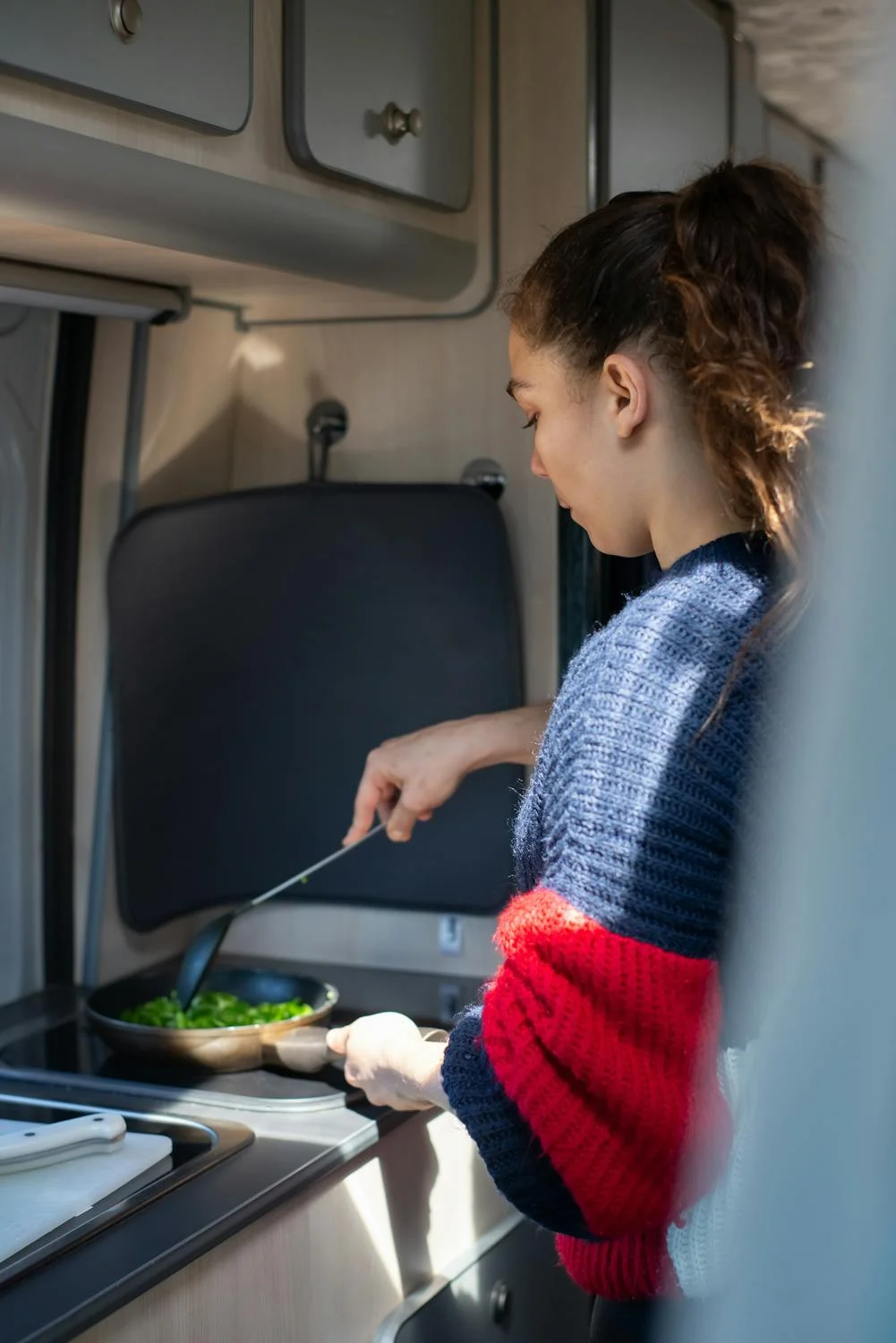
Cooking amenities
- Both the Sprinter and the Winnebago had a microwave, which was nice to have but certainly not a first choice due to the power consumption.
- The Sprinter had an induction cooktop, which was convenient, but again, you had to monitor power usage closely.
- The Winnebago and the THOR had a built-in two-burner propane stove: convenient, but one more fuel type to monitor.
Air conditioning
- For the time of year David was traveling through Georgia, the 12v air conditioner in the Sprinter was sufficient and kept them cool on their trip.
- The Winnebago’s AC felt grossly underpowered, and they had to be plugged into shore power to use it at all. Even when parked at a campground, the unit would not cool the camper van enough.
- The THOR did not have AC, but for the trip that David took, this wasn’t an issue.
Storage capacity
- Due to the Murphy bed setup, storage space in the Travato was severely lacking. The tradeoff was the simple bed conversion process and added living space when the bed wasn’t down.
- The Mercedes Sprinter had a large “garage” under the queen bed, as well as ample storage space in upper cabinets.
- THOR’s storage capacity was lacking and was one of the things that David was not a fan of. It would have been difficult to have more than a weekend’s worth of items in the camper, and full-time living would be even more difficult.
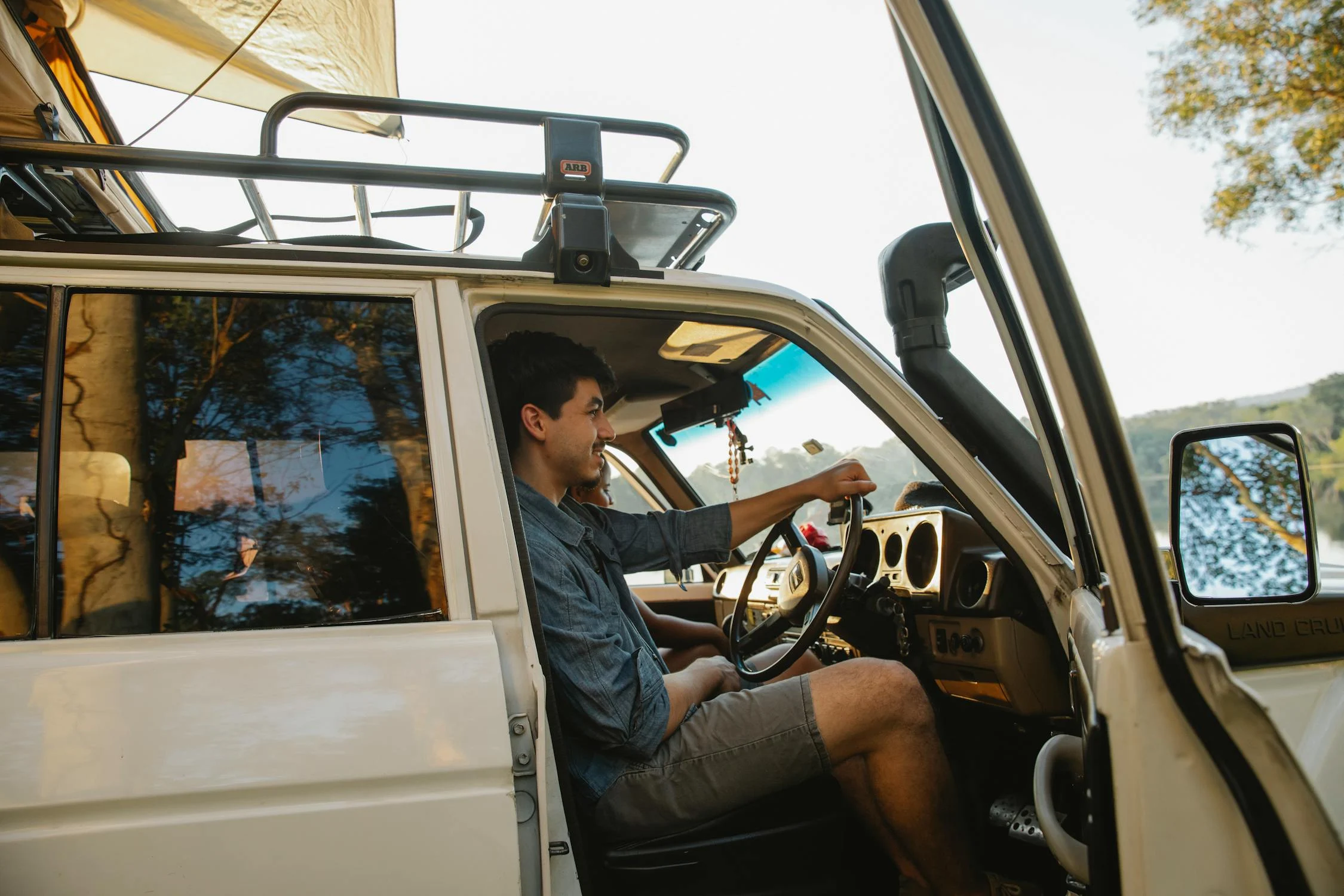
Aesthetics
- The Mercedes Sprinter looked good inside and out, with the stylish lines that Mercedes is known for and an interior that was warm and homey.
- The Winnebago was more… well… manufactured. There were obvious sealant lines on the roofline that were rather ugly, and the interior was more “sterile” without the uniqueness of the professionally converted campervan.
- THOR’s aesthetics were somewhere in between. Overall, David wasn’t a fan of the Promaster “base,” but that’s more of a personal preference. Inside, although more functional than the Winnebago, it still looked and felt a little cookie-cutter, which is fair because it is, after all, a manufactured van.
Overall usability
- The professionally converted camper van was more intuitive and literally felt like a little home on wheels. The layout made sense, storage was convenient, there was ample power, and it had everything David needed for his trip.
- The Winnebago, although functional, felt cramped and less homey. The bathroom layout was poor, and there was limited storage space which made the trip more challenging. It was also less intuitive, which meant David spent more time trying to learn the systems instead of enjoying the trip and spending time with his son.
- THOR’s layout was very intuitive and just felt good, with lots of room to move around and everything you needed to remain fully self-contained during your trip. The only drawback was having to “make” your bed each evening instead of having the fixed bed or Murphy bed the other camper vans had.
- All three camper vans had adequate power capacity for off-grid needs and good freshwater storage.
- For interior lighting, the Mercedes and the THOR had ample, well-placed lights, but the Winnebago was definitely lacking in this area.
With David’s first-hand experience previously living full-time in a class B camper van, he felt the professionally converted Sprinter van was the clear winner here, but someone just looking for a capable rig to take shorter trips in might be just as pleased with the Winnebago Travato. The THOR Motorcoach Scope 18M was a close second and easily could be a pleasing option for the solo traveler or a couple who goes out often for weekend road trips.
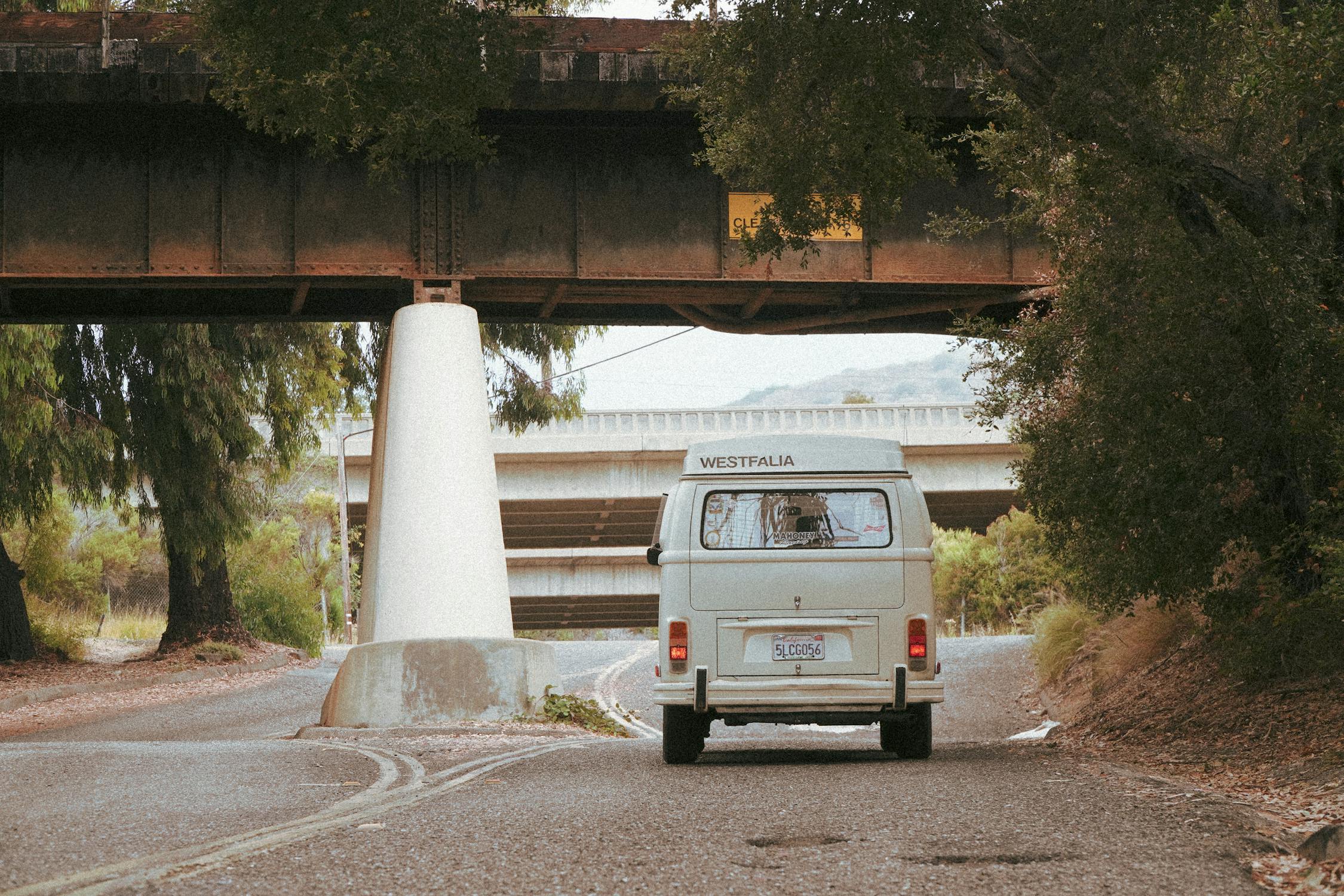
Conclusion
The choice between Class B van conversions from a major manufacturer or a professional campervan conversion company ultimately depends on your budget, customization preferences, and priorities.
Major manufacturer RVs offer a level of quality and reliability, while professional campervan conversions provide more customized layout options from fellow van lifers who know what it is to live in a camper van full-time.
Careful consideration and thorough research are essential in making the right decision to ensure your Class B RV suits your travel needs and expectations.
SHARE THIS POST
